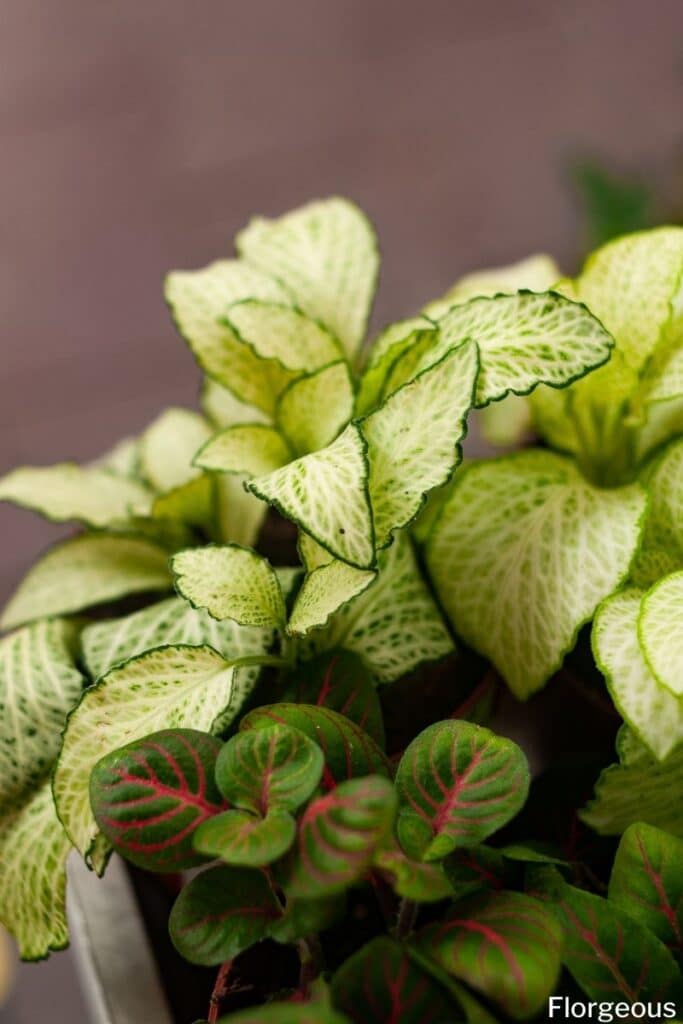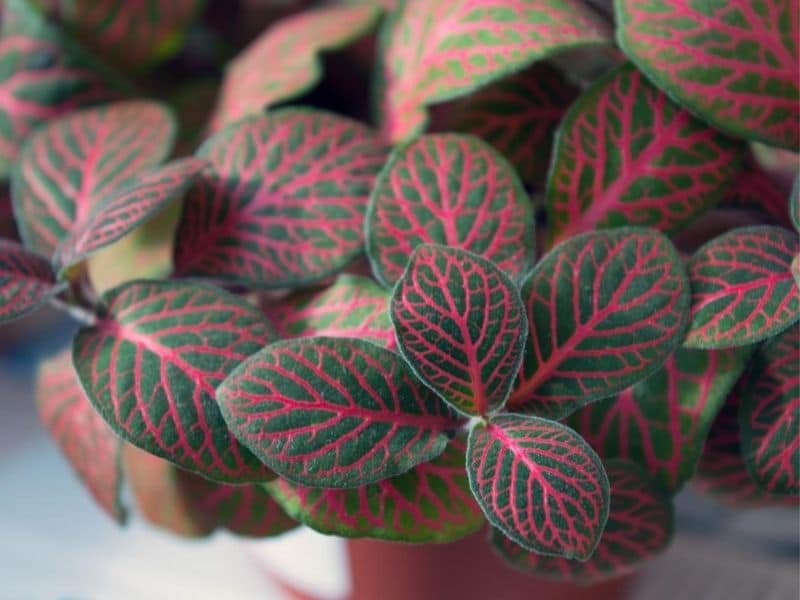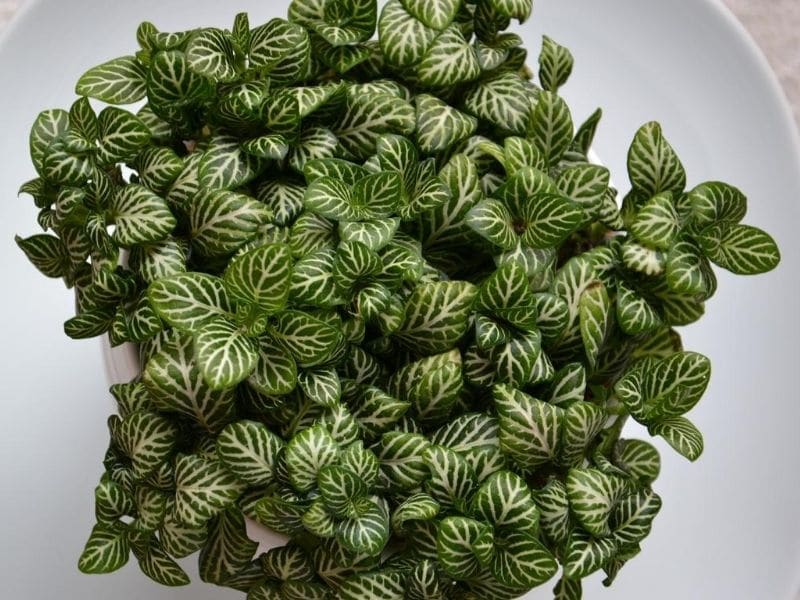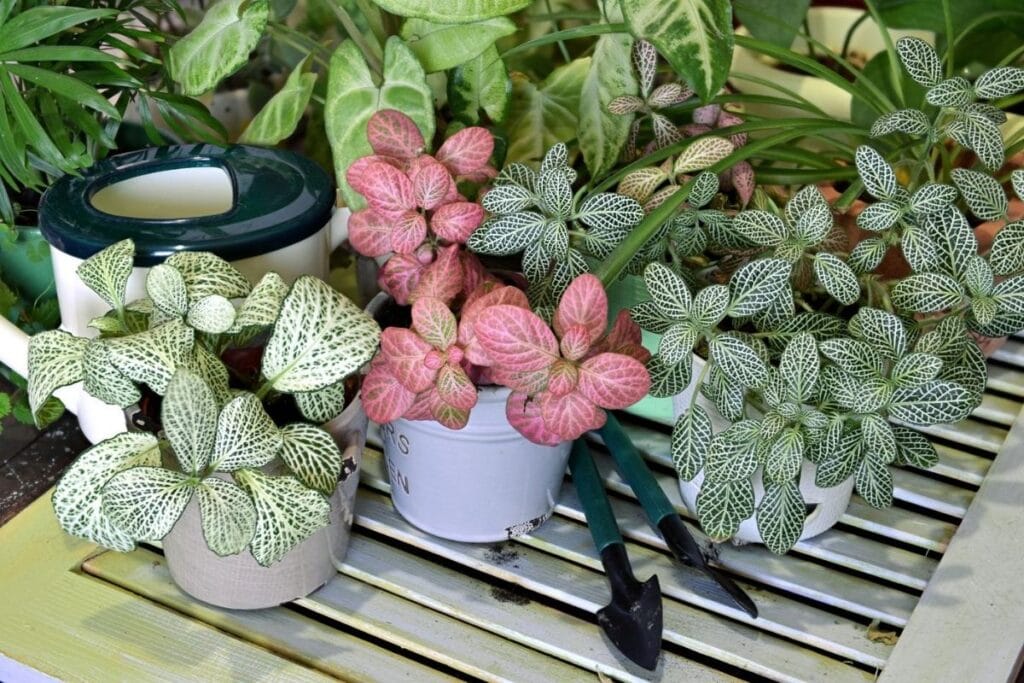Low growing with a spreading habit type of plants is some of the best to grow in pots because they create a compact and healthy appearance which is always a welcome sight. A good example of this is the fittonia plant, a favorite indoor plant for tables, terrariums and macrame hanging pots. It is an outstanding plant to keep with its striking foliage that is always easy to maintain.
A popular foliage house plant, Fittonia or Fittonia albivenis is actually a genus of low-spreading evergreen perennials that originally grew in Peru but is found in the Andean rainforests of South America too (1).
Cultivated as a groundcover, nerve plants grow sideways and low and can only reach up to 30cm high. The roots are shallow and it occasionally blooms tiny greenish flowers in the middle of greenish bracts (2).
This small plant could easily be dismissed if not for the eye-catching network of white veins criss-crossing its deep green ovate leaves. This is the reason why the fittonia goes by other names such as nerve plant, mosaic plant, and painted net leaf.
Outdoors, fittonias work well with large plants as they can prosper and be tucked underneath them. They are also very effective in pots, creating small lush and bold masses of indoor plants. Terrariums are where fittonias thrive best as they love the mini rainforest environment there (3).
Plant Facts
| Scientific name | Fittonia albivenis |
| Common names | Nerve plant, mosaic plant, painted net leaf, Fittonia argyroneura |
| Family | Acanthaceae |
| Plant Type | Houseplant, groundcover |
| Height and Width | 6in.-1 ft. tall (indoors), 1-2 ft. wide (indoors) |
| Origin | Perú, Ecuador, Colombia |
| Flower colors | White |
| Foliage color | Green, white, pink |
| Sun Exposure | Bright indirect light |
| Soil Type & pH | Moisture-retaining, slightly acidic soil |
| Special features | Compact growth form, colorful foliage, suitable for terrariums |

How to Grow the Nerve Plant
When growing outdoors, plant individual fittonias 6 inches apart. They should not be planted too deep, just at the level of the ground to keep the deep green leaves leaves away from the soil and avoid pests and diseases. Organic mulch should be applied and worked into the soil as it decomposes (2).
They will grow year round indoors under fluorescent light but come summer, they should be put outside to grow thicker and to keep the color vibrant. Pinching off developing flowers will also promote bushier growth (1).
Propagation
Propagating new nerve plants is easy. Stem cuttings strike well, whether set in water or soil. Cuttings in soil will need to be kept moist and humid under plastic for example. Keeping them in a humid environment is necessary so that moisture can be taken in by the leaves while the plant develops roots.
Soil
A peat-based general purpose potting soil is ideal for the nerve plant. The growing medium should be able to hold onto moisture without remaining saturated. This slightly acidic soil also mimics the rainforest floor where this plant grows in nature.

Pruning
Sometimes, fittonias will get too leggy if there is not enough light exposure. Also, the spreading stems that spill over the pot tend to dry out because the growing roots are not getting enough moisture.
These overgrowths should be trimmed to strengthen the plant’s form and since fittonias can easily develop roots, these cuttings can also be used as propagules. They can be readily inserted into the soil and allow the roots to form (4).
Repotting and Transplanting
Choose a container that is about 2 inches (5 cm) larger than the current pot. Make sure that the new container has drainage holes, or drill the bottom if necessary.
Water the fittonia plants well before removing and take care not to damage or disturb the roots unnecessarily. Some soil should be placed in the new container to cover the bottom before the plant is added. Fill in the soil around the plant after adding it to the new pot and then water lightly.

How to Care for Nerve Plant
Fittonias are easy to care for in most homes as long as you have a warm, humid spot with bright indirect light. Pay attention to the plant’s water needs and you should have no problem keeping this plant in good health. Read on for more nerve plant care tips.
Water
A moisture-loving plant, the fittonia likes regular watering but only when the top soil is dry. If the soil gets too wet, the leaves will turn yellow and if too dry, the leaves will wilt. Fittonias are not drought-tolerant but they will perk up once watered. You should avoid overwatering to prevent soggy soil (4).
Sudden collapse of the fittonia nerve plant is also common, especially when the plant is left without care for days. Prolonged dehydration can be fatal to the plant so make sure that the plant is well-watered (5).

Sunlight
Because nerve plants naturally grow on rainforest floors, they need indirect or dappled sunlight (1). Too much exposure to direct sunlight will cause the leaves to burn so it is important to mimic its natural environment indoors. They should be placed in a northern or eastern window. In the garden, grow fittonias in warm shady areas.
Temperature and Humidity
Fittonias do not like extremes and will experience shock and possible decline when exposed to these. The ideal temperature for them to survive is 60-80°F (16-26°C). An average room temperature is enough but during winter, it is best to keep them away from cold drafts and heaters.
Nerve plants appreciate high humidity and an effective way to provide the preferred moist air is by misting every morning. Placing the potted plant on a wet pebble tray will also increase humidity around the plant (1).
Fertilizer
Given the right growing conditions, nerve plants are fairly easy to grow. But they will need supplements to keep the whole plant healthy and lasting. Application of fertilizer can be done once a month by mixing a complete soluble fertilizer with water and spraying on the leaves and the soil.
Pest and diseases
Mealybugs and aphids often attack the new growth of fittonias. This can be remedied by isolating the plant and manually removing the pests with tweezers or a cotton swab dipped in alcohol.
This should be done regularly until there are no signs of pests. Strong commercial pesticides are not recommended as they may damage the delicate leaves (5).The soft stems and leaves of nerve plants and the moist soil that they need make them vulnerable to fungus infection.
Water and neem oil mixture applied to the soil is an effective way of getting rid of gnats but if the plant has been kept in standing water for too long, it is best to repot with fresh soil mixture.
Common Varieties and Cultivars
There are several beautiful nerve plant varieties available in the horticultural trade. Leaf size, shape, and texture vary to some extent, but the major difference between these plants is the color of the leaf venation.
These varieties are classed into two broad groups, namely the Argyroneura group with light-colored venation, and the Verschaffeltii group with darker venation.
Some popular varieties include:
- ‘Frankie’
- ‘Titanic’
- ‘Leather Leaf’
- ‘Fortissimo’
FAQs
How do you keep nerve plants healthy?
To keep nerve plants (Fittonia) healthy, provide them with bright, indirect light, maintain consistently moist but not waterlogged soil, and ensure adequate humidity. Regularly misting the plant or placing a tray of water nearby can help maintain humidity.
What does an overwatered nerve plant look like?
An overwatered nerve plant may exhibit symptoms such as yellowing leaves, wilting, or root rot. The soil should be kept consistently moist but not excessively wet, and proper drainage is crucial to prevent overwatering issues.
How do you make a nerve plant bushy?
To encourage a nerve plant to become bushy, regularly pinch or trim the growing tips. This practice prompts the plant to produce side shoots, resulting in a fuller and more compact appearance. Additionally, providing the plant with bright, indirect light and maintaining optimal humidity levels supports healthy, bushy growth.
Conclusion
Fittonias are small plants with big appeal. It is hard to pass them by without stopping to admire the intricately marked leaf venations of these tropical evergreens, especially when nerve plant flowers with those dark green leaves around. These terrific houseplants are easy to care for and come in such a wide variety of colors that there’s one to suit every home.
References
Reference list
(1) Southern, N. “How Not to Kill Plants”. 2017. Hachette UK. P. 256.
(2) Neal, N. “Gardener’s Guide to Tropical Plants”. 2012. Cool Springs Press. P. 240
(3) Colletti, M. “Terrariums-Gardens Under Glass”. 2015. Cool Springs Press. P. 176.
(4) Zachos, E. “Growing Healthy Houseplants”. 2014. Storey Publishing. P. 128.
(5) Pleasant, B. “The Complete Houseplant Survival Manual”. 2012. Storey Publishing. P. 384.
Close
*Image by Samiramay/depositphotos







